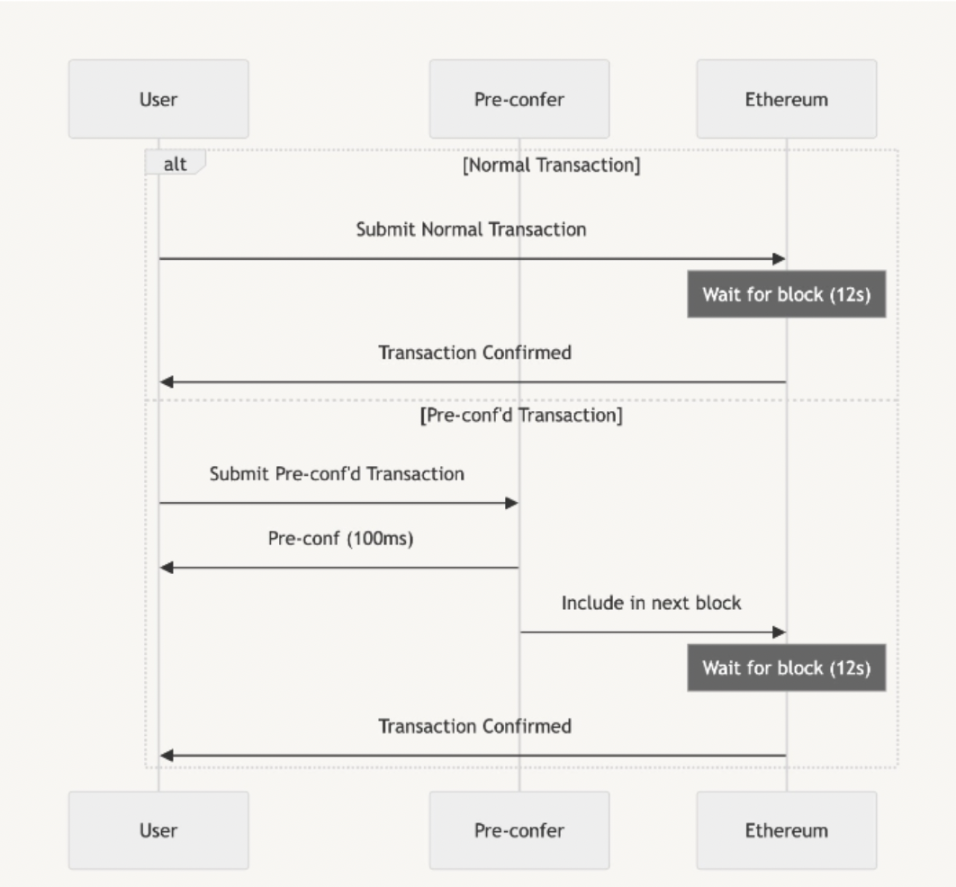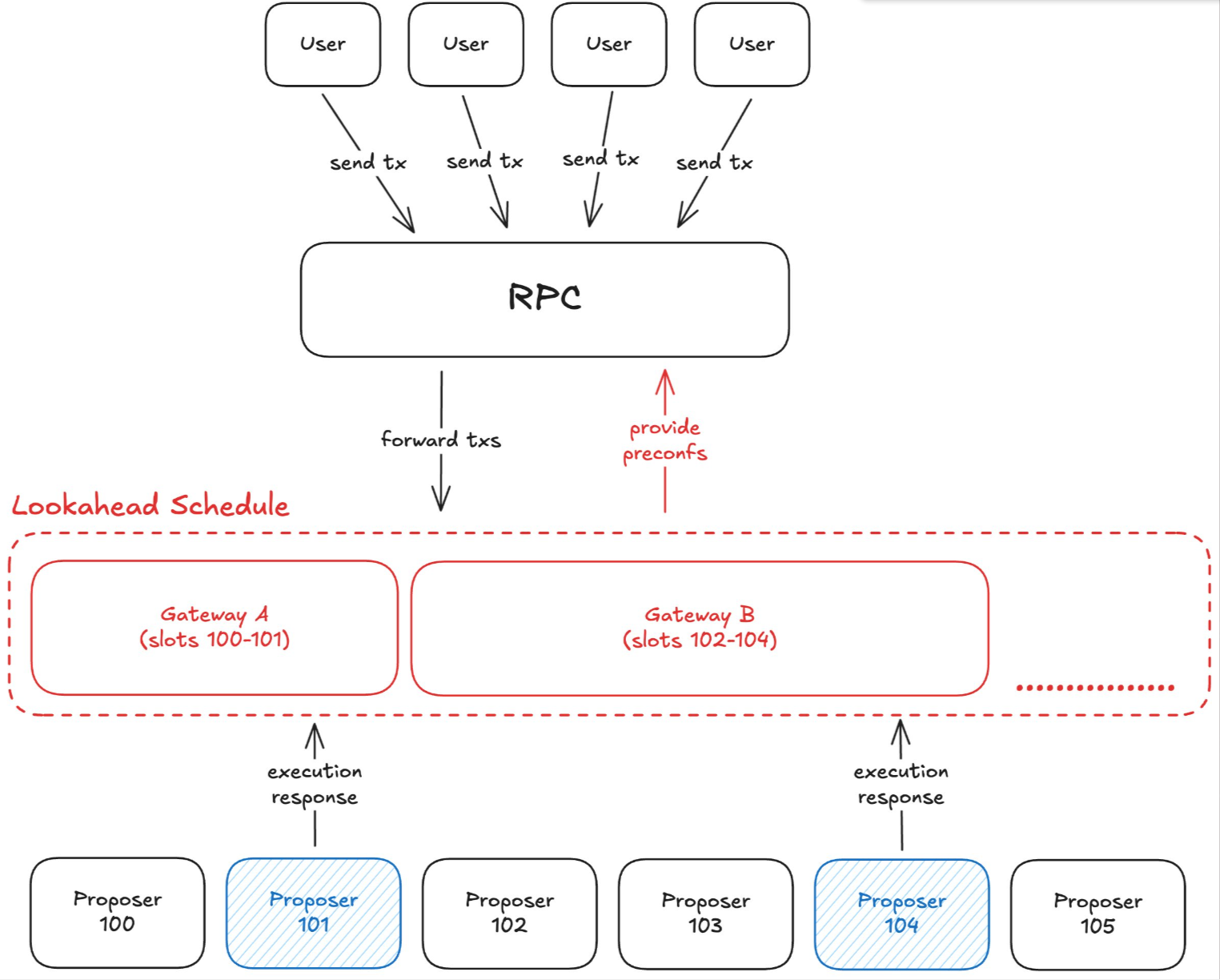Preconfs Evolution: From "Patches" to "Infrastructure"—How Does UniFi AVS Impact the Rules of the Game for Based Rollups?
Written by: Web 3 farmer Frank
Why has Based Rollup, considered the "orthodox" ultimate scaling solution for Ethereum, been "praised but not popular"?
On the one hand, it achieves the most thorough security and decentralization alignment with the mainnet by returning the ordering power to L1. On the other hand, it has to endure a confirmation delay of up to 12 seconds, which almost makes high-frequency trading and real-time financial scenarios impossible.
Therefore, Preconfs were proposed as a necessary patch for Based Rollup, attempting to smooth out latency with sub-second transaction commitments. However , for a long time, Preconfs remained in a small-scale, non-standardized exploratory stage, lacking a unified mechanism and stable returns, and has never truly achieved large-scale implementation.
Recently, Puffer Finance launched its Ethereum security infrastructure product, "UniFi AVS," which finally attempts to upgrade Preconfs from temporary performance patches to reusable standardized infrastructure, aiming to achieve a confirmation speed of sub-10 ms and introduce institutionalized design in terms of security and economic incentives.
This article will analyze UniFi AVS's core capabilities, technological path, and ecosystem impact from an industry observer's perspective, and discuss whether it can truly become a key variable in the Based Rollup—and even the broader Ethereum Rollup ecosystem.

I. UniFi AVS: Preconfs, no longer just "patching"
To understand the importance of this upgrade, we need to first review the core logic of Based Rollup.
In Ethereum's scaling narrative, Based Rollup fully aligns with the mainnet in terms of security and decentralization by returning the ordering power to L1 validators, but this also brings an unavoidable trade-off—while inheriting the security of the mainnet, it also introduces a block confirmation delay of about 12 seconds.

Therefore, preconfs have become a necessary patch for Based Rollups, responsible for providing users with a commitment to transaction execution before the transaction is actually submitted to L1 (further reading: " Understanding Puffer UniFi AVS: From Preconfs to Ethereum's Next Decade? "). It can be said that if Based Rollups are to be fully realized, permissionless, neutral and flexible preconfs services must be implemented.
However, for a considerable period of time, Preconfs remained largely in the "small workshop" stage (non-standardized, peer-to-peer solutions), typically operated by a few nodes or project teams on their own. They lacked unified standards and stable revenue models. If the node responsible for preconfirmation went offline or acted maliciously, transactions could become invalid or even be attacked by MEVs, resulting in serious deficiencies in reliability and sustainability.
Puffer's UniFi AVS is a systematic solution to this dilemma. It no longer treats Preconfs as temporary patches, but upgrades them into a callable infrastructure layer. The core idea is to reconstruct Preconfs into a standardized cloud service like AWS.
Specifically, UniFi AVS operates on three main lines: enabling Based Rollups to run faster, generating sustainable returns, and providing institutionalized security mechanisms.
- In terms of performance, transaction confirmation is compressed to sub-10 ms, bringing an instant user experience comparable to Solana or even centralized exchanges;
- From an economic perspective, through a protocol-level revenue-sharing mechanism, Rollups no longer "work for L1" but instead share revenue with validators and gateways;
- In terms of security, relying on the guarantee and slashing mechanism of up to $13 billion in Rested ETH, "verbal promises" are transformed into "costly contracts," forming institutional constraints.
For developers and Rollup projects, the emergence of UniFi AVS means that they no longer need to design and maintain complex sorting and confirmation logic themselves. Instead, they can directly access a proven pre-confirmed infrastructure, just like calling AWS cloud services. It is plug-and-play and expandable on demand, allowing them to focus more on product and user aspects.
This modular design also allows Preconfs to be further productized and generate spillover effects—not only can Rollup projects avoid reinventing the wheel, but wallets, DApps, and upper-layer protocols will also be able to access them through standardized APIs and uniformly enjoy the capabilities of "instant confirmation + economic alignment + security guarantee," truly making "speed and stability" a public underlying service of the Ethereum ecosystem.
From this perspective, UniFi AVS allows Preconfs to transcend their role as simple performance patches, and instead standardizes performance, profitability, and security all at once, propelling them from an add-on function to a middleware infrastructure for Ethereum scaling, paving a more sustainable path for the large-scale deployment of Based Rollups.
It is worth noting that Puffer also emphasized that UniFi AVS is not limited to Based Rollup. By design, its registry mechanism can also provide sub-10 ms instant acknowledgment capability for any OP Stack Rollup, and plans to support more Rollup architectures in the future. In other words, it is positioned as a general pre-acknowledgment infrastructure with cross-architecture potential.
Of course, it remains uncertain whether all Rollups are willing to relinquish Sequencer revenue to AVS, and it can even be asserted that this will be difficult to achieve in the early stages—after all, the sorter is never just a technical issue, but a deeply intertwined issue of profit distribution:
In an L2 economic system, who is responsible for dividing the pie, who is to whom the pie is planned, and how it should be divided?
Therefore, whether Preconfs will eventually evolve into a public standard for the entire Rollup ecosystem or primarily serve the Based path is not only a choice of technical route, but also a game of business models and profit distribution, and it is bound to be an issue that needs to be continuously observed in the coming years.
II. How can Preconfs be refactored into standardized infrastructure?
Objectively speaking, since the concept of Rollup was proposed, Ethereum's scaling has not lacked a concept, but rather the ability to implement it in engineering.
After all, for a technology to evolve from a clever "function" into a robust "infrastructure," it typically needs to meet three core conditions: a clear service commitment, reliable security guarantees, and a sustainable economic model.
In other words, it is about moving from a technical concept to an "engineering" implementation, which is the only way to make it truly capable of large-scale operation. Puffer's UniFi AVS approach is similar to this—reconstructing Preconfs from scattered, small-scale trials into a reusable, scalable, and economically incentivized infrastructure.
In other words, how can we ensure that Preconfs are no longer "temporary commitments" to certain nodes, but are designed as a standardized network service?
1. Execution Preconfs: From "Block Input Guarantee" to "Execution Guarantee"
The first step was to upgrade from Inclusion Preconfs to Execution Preconfs.
In the traditional Inclusion Preconfs mode, users are only promised that their transactions will be included in the block, but the state of the transaction at the time of execution cannot be guaranteed. Therefore, users may still experience price slippage or even MEV pre-emption.
Execution Preconfs are further upgraded to "execution guarantees", which ensure that the transaction will be executed in the state when the user submits the order - once the user places an order, the state will be locked, and the transaction will only be executed in this state; otherwise, it will not be valid.
For example, if you place an order to buy ETH at a price of 4400 USDC:
- In Inclusion mode, by the time the transaction is actually executed, the market price may have become 4410 USDC, and the transaction will still be completed, but the transaction price will not be the 4400 you expected.
- In Execution mode, the system will guarantee a transaction price of 4400 USDC regardless of market fluctuations. The transaction will only be executed if this condition is met.
This upgrades Preconfs from "early entry tickets" to "certain transactions," significantly improving the user experience and providing greater reliability for price-sensitive financial applications such as DeFi, derivatives, and payments.

2. Gateway Architecture and Frags Technology: Latency Compression to Below 10 Milliseconds
Puffer also introduced the Collateral-backed Gateway architecture (pioneered by the Gattaca team), which allows L1 proposers to delegate pre-acknowledgment execution authority to a more specialized Gateway.
By leveraging fragment technology and the lookahead mechanism, Gateway can process transactions before the official block is produced, shortening the window period for state transitions. Theoretically, under optimal configuration, transaction latency can be reduced to below 10 milliseconds (sub-10 ms).
This theoretically allows its user experience to reach the level of high-performance public chains such as Solana.
3. Restaked ETH Security Endorsement: Making Commitments "Cost-Based"
In the past, Preconfs largely relied on nodes' "self-discipline," and users received almost no compensation if they went offline or acted maliciously.
The upgraded Puffer uses EigenLayer's restaking mechanism to ensure that each Gateway is backed by ETH staked by validators (implemented in stages). If a node becomes inactive, it may be penalized with 1 ETH; if it maliciously withdraws MEV or violates its commitment, it may trigger a slashing of up to 1000 ETH.
Unlike PoS penalties, Preconf's slashed ETH compensates users of Preconf services, directly enhancing economic alignment. It transforms the soft commitment that previously relied on node reputation into a hard commitment with a clear slashing mechanism, significantly improving institutional constraints.
At the same time, Puffer has established the Canonical Preconf Gateway Registry to ensure that all gateways enter an orderly, open, and verifiable registration system.
4. Programmable profit sharing: Institutionalized multi-party value distribution
Speed and security alone are not enough; for Preconfs to become infrastructure, they must also be sustainable.
To this end, the upgraded UniFi AVS incorporates a Rewards Distributor, allowing for flexible distribution of rewards among Rollup teams, Ethereum proposers, and Gateway providers, achieving programmable revenue sharing at the protocol level.
- Rollup team: Retain some transaction fees, no longer "working for L1";
- Ethereum proposers (validators): Earn additional income by providing preconfs;
- Gateway providers are incentivized to operate networks and ensure service stability;
The revenue sharing is no longer a temporary agreement, but a system written into the agreement and executed automatically, forming a long-term closed loop of economic alignment among Rollup, validators, and Gateway.
This multi-dimensional mechanism design is the key to Preconfs' transformation from a single-point solution to a scalable and trustworthy public infrastructure.
III. Beneficiary Map in a Multi-Party Game
Any infrastructure upgrade is not just a technological evolution, but also a redistribution of interests.
What makes UniFi AVS special is that it binds performance, security, and economic incentives together, allowing multiple ecosystem roles to find value in the same mechanism—from Rollup project teams to Ethereum validators, developers, and end users. It transforms Preconf from a patch into a sustainable, modular service, enabling all participants to benefit from a more robust system.
First and foremost, the Rollup project team gained the double benefit of improved performance and increased revenue.
In the past, Based Rollup was criticized by the market for being "slow and unprofitable," especially since its economic model almost entirely favored L1 validators. With the help of UniFi AVS's Execution Preconfs, Rollup can achieve sub-10 ms confirmation speeds with a plug-and-play approach, significantly improving the user experience.
Meanwhile, the revenue-sharing mechanism at the protocol layer allows the Rollup team to retain some economic benefits without having to rely entirely on external subsidies. For the project team, this is a double benefit of increased speed and shared profits.
Secondly, Ethereum validators/restakers have gained new sources of income.
Because L1 validators are the direct implementers of Preconfs, by participating in UniFi AVS, validators can obtain new Preconf service revenue in addition to traditional block rewards.
At the same time, Rested ETH not only provides security assurance, but also increases the earning opportunities for validators, which in turn enhances the attractiveness of staking ETH, thereby strengthening the overall economic security of Ethereum and transforming validators from simply running nodes to "providing value-added services and obtaining additional income".
In addition, Gateway providers are also included, and their roles have been formally institutionalized in this upgrade.
Puffer established a Canonical Gateway Registry, making the Gateway a standardized node in the network, rather than just a temporary role. After obtaining delegation rights, the Gateway can achieve pre-acknowledgments in less than 10 milliseconds by running frags technology and lookahead mechanism.
Their services are directly linked to economic incentives and are subject to slashing mechanisms, resulting in both revenue and costs. This transforms Gateway from a "volunteer" into a true infrastructure service provider.
At the same time, developers can gain access to a lower barrier to entry and greater composability.
In the past, if developers wanted to implement instant confirmation on Rollups, they often had to build complex mechanisms themselves, which was both time-consuming and difficult to standardize. However, the upgraded UniFi AVS allows developers to directly access instant confirmation capabilities through modular APIs, just like calling cloud services.
Whether it's DEX, derivative protocols, or high-frequency GameFi applications, they can quickly enjoy the improved experience brought by sub-10 ms confirmation. This not only reduces the cost of infrastructure construction but also reduces the risk of MEV theft, allowing developers to focus more on application-layer innovation.
Finally, there are the ordinary users, who are the most direct beneficiaries, experiencing a smooth experience on Ethereum Rollups for the first time, comparable to Solana and even approaching that of a CEX:
- In terms of speed, transaction confirmation time has been reduced from 12 seconds to 10 milliseconds, providing an experience comparable to centralized exchanges;
- In terms of certainty, Execution Preconfs guarantee price locking at the protocol commitment level, avoiding slippage and preemptive moves;
- In terms of security, Restated ETH backing and the Slashing mechanism make commitments "costly," allowing users to receive compensation when they default.
From a higher perspective, the upgrade of Puffer UniFi AVS is not just a product evolution, but also an establishment of industry standards for Preconfs, upgrading them from patches to infrastructure, and even turning them into standardized middleware services for Ethereum.
This not only makes Based Rollups truly capable of running fast, earning money, and being secure, but also reinforces Ethereum's long-term narrative as a Security Settlement Layer.
In conclusion
Looking back at Ethereum's scaling process over the past 5 years, Rollup has undoubtedly been the main theme, but how to find a truly feasible balance between performance, economy and security has always been an unresolved "impossible triangle".
In particular, the Ethereum "orthodox scaling path" of Based Rollup has been stuck at the last piece of the puzzle for large-scale and commercial operation. So, objectively speaking, the UniFi AVS launched by Puffer this time can be regarded as one of the highly feasible explorations to fill in this puzzle.
The deeper significance lies in the fact that it paints a clear "endgame" scenario for the future of modular blockchains: any emerging Rollup will not need to reinvent the wheel, but can be built directly on UniFi AVS to quickly achieve performance comparable to Solana, Ethereum mainnet-level security, and a self-consistent economic model.
However, whether it can ultimately become an industry consensus depends not only on the robustness and openness of its own design, but also on whether it can find the optimal balance point in the complex Rollup ecosystem and the game of interests among multiple parties.
Therefore, for the industry, this is a key observation window in the next one to two years to measure whether the Based Rollup narrative can truly mature.
- 核心观点:UniFi AVS将预确认升级为标准化基建。
- 关键要素:
- 交易确认速度提升至10毫秒内。
- 引入再质押ETH安全与罚没机制。
- 协议层可编程收益分润设计。
- 市场影响:推动以太坊Rollup规模化应用。
- 时效性标注:中期影响



